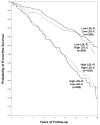LDL Particle Number and Risk of Future Cardiovascular Disease in the Framingham Offspring Study - Implications for LDL Management
- PMID: 19657464
- PMCID: PMC2720529
- DOI: 10.1016/j.jacl.2007.10.001
LDL Particle Number and Risk of Future Cardiovascular Disease in the Framingham Offspring Study - Implications for LDL Management
Abstract
Background: The cholesterol content of LDL particles is variable, causing frequent discrepancies between concentrations of LDL cholesterol and LDL particle number. In managing patients at risk for cardiovascular disease (CVD) to LDL target levels, it is unclear whether LDL cholesterol provides the optimum measure of residual risk and adequacy of LDL lowering treatment.
Objective: To compare the ability of alternative measures of LDL to provide CVD risk discrimination at relatively low levels consistent with current therapeutic targets.
Methods: Concentrations of LDL cholesterol (LDL-C) and non-HDL cholesterol (non-HDL-C) were measured chemically and LDL particle number (LDL-P) and VLDL particle number (VLDL-P) were measured by nuclear magnetic resonance (NMR) in 3066 middle-aged white participants (53% women) without CVD in the Framingham Offspring cohort. The main outcome measure was incidence of first CVD event.
Results: At baseline, the cholesterol content per LDL particle was negatively associated with triglycerides and positively associated with LDL-C. On follow-up (median 14.8 yrs), 265 men and 266 women experienced a CVD event. In multivariable models adjusting for non-lipid CVD risk factors, LDL-P was related more strongly to future CVD in both sexes than LDL-C or non-HDL-C. Subjects with a low level of LDL-P (<25(th) percentile) had a lower CVD event rate (59 events per 1000 person-years) than those with an equivalently low level of LDL-C or non-HDL-C (81 and 74 events per 1000 person-years, respectively).
Conclusions: In a large community-based sample, LDL-P was a more sensitive indicator of low CVD risk than either LDL-C or non-HDL-C, suggesting a potential clinical role for LDL-P as a goal of LDL management.
Figures


References
-
- Friedewald WT, Levy RI, Fredrickson DS. Estimation of the concentration of low-density lipoprotein cholesterol in plasma, without use of the preparative ultracentrifuge. Clin Chem. 1972;18:499–502. - PubMed
-
- Sniderman A, Vu H, Cianflone K. Effect of moderate hypertriglyceridemia on the relation of plasma total and LDL apoB levels. Atherosclerosis. 1991;89:109–16. - PubMed
-
- Jeyarajah EJ, Cromwell WC, Otvos JD. Lipoprotein particle analysis by nuclear magnetic resonance spectroscopy. Clin Lab Med. 2006;26:847–70. - PubMed
-
- Executive Summary of The Third Report of The National Cholesterol Education Program (NCEP) Expert Panel on Detection, Evaluation, and Treatment of High Blood Cholesterol in Adults (Adult Treatment Panel III) JAMA. 2001;285:2486–97. - PubMed
-
- Grundy SM, Cleeman JI, Merz CN, Brewer HB, Jr, Clark LT, Hunninghake DB, Pasternak RC, Smith SC, Jr, Stone NJ. Implications of recent clinical trials for the National Cholesterol Education Program Adult Treatment Panel III guidelines. Circulation. 2004;110:227–39. - PubMed
Grants and funding
LinkOut - more resources
Full Text Sources
Other Literature Sources
Medical
